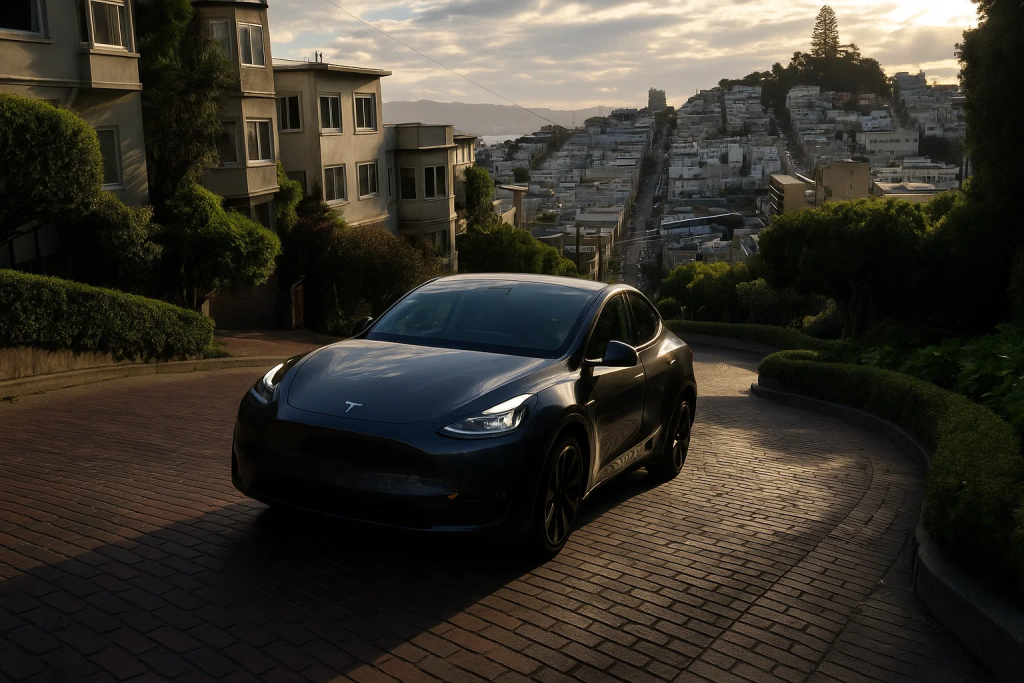Tesla Eyes San Francisco for Next Phase of Robotaxi Rollout
Tesla is preparing to bring its robotaxi service to the San Francisco Bay Area within the next two months, according to CEO Elon Musk. The move represents a significant expansion of the program following its limited debut in Austin, Texas in June, and positions Tesla for a direct contest with market leader Waymo in one of the most closely watched regions for autonomous vehicles.

In Austin, Tesla currently operates its robotaxi service using modified Model Y vehicles, charging riders a flat $4.20 per trip. The service is available to a small group of pre-selected passengers and operates only in clear weather conditions. Safety monitors are stationed in the front passenger seats as part of Tesla’s limited-autonomy strategy. While Musk confirmed a wider service area would launch in Austin this weekend, he provided no specifics on the geographic expansion.
The service’s debut in California is contingent on Tesla clearing a far more complex regulatory landscape. Unlike Texas, where the company faced virtually no oversight, California enforces rigorous standards for autonomous vehicle deployment. Tesla must secure approvals from both the California Department of Motor Vehicles (DMV) and the California Public Utilities Commission (CPUC). The CPUC granted Tesla an initial license in March, but full commercial deployment still hinges on additional data and testing benchmarks.
Tesla engineers have reportedly been collecting data using LiDAR-equipped validation vehicles in Austin, even though Tesla’s production models typically rely on camera-based Full Self-Driving (FSD) systems. The data is being used to refine performance metrics and improve demand forecasting. Tesla recently hosted a hiring event in Austin aimed at reducing reported 15-minute wait times by bringing on additional human operators to assist with routing and vehicle repositioning.
A San Francisco rollout would place Tesla in head-to-head competition with Alphabet’s Waymo, which currently operates approximately 1,500 autonomous vehicles across multiple cities, including a robust presence in the Bay Area. Waymo’s system is considered more mature and has been tested extensively under California’s strict regulatory protocols.
Tesla’s robotaxi program is seen as a linchpin in its broader vision of a fully autonomous transportation future. With electric vehicle sales showing signs of stagnation and investor focus shifting toward AI-driven automation, the company is under pressure to demonstrate real-world traction with its autonomy and robotics platforms. Musk claimed Tesla could soon reach a ratio of three autonomous vehicles for every one human supervisor, indicating the company’s confidence in scaling its fleet efficiently.
Despite setbacks, including reports of Tesla robotaxis involved in minor accidents, Musk has continued to push an aggressive timeline. He frames autonomy as central to Tesla’s valuation and strategic future, often reiterating that real-world data collection and machine learning improvements are the backbone of Tesla’s Full Self-Driving efforts.
As Tesla prepares for regulatory hearings and final approvals in California, its competitors are not standing still. Waymo recently expanded testing to Philadelphia and continues to tweak its services in cities like Los Angeles and Phoenix. Meanwhile, Tesla’s robotaxi ambitions remain a high-stakes bet that could either reinforce its dominance in next-generation mobility, or expose the limits of its autonomous strategy under greater scrutiny.